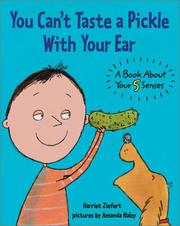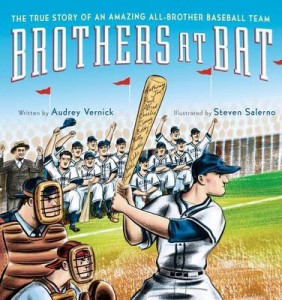You Can’t Taste a Pickle With Your Ear
 When it comes to Common Core State Standards, the one that I think is the most fun is Range of Reading. (I know, I know, all the CCSS are fun, but this one is the most fun!) Range of Reading: Informational Text means we want kids to “read and comprehend informational texts, including history/social studies, science, and technical texts.” In other words, we can share all kinds of cool nonfiction books with our students, and I have a fun pick this week.
When it comes to Common Core State Standards, the one that I think is the most fun is Range of Reading. (I know, I know, all the CCSS are fun, but this one is the most fun!) Range of Reading: Informational Text means we want kids to “read and comprehend informational texts, including history/social studies, science, and technical texts.” In other words, we can share all kinds of cool nonfiction books with our students, and I have a fun pick this week.
You Can’t Taste a Pickle With Your Ear: A Book About Your 5 Senses by Harriet Ziefert with pictures by Amanda Haley is an informational picture book with a great sense of humor. It has some nice text features like a table of contents, an introduction, a conclusion, and questions at the end of each mini-chapter for discussion. The information presented about the five senses is appropriate for early elementary students and will work well for any “all about me” units as well as for health and science studies.
Read aloud the title You Can’t Taste a Pickle With Your Ear and you’ll get students grinning. You can read the 32-page book in one sitting, or read each mini-chapter devoted to a different sense one at a time. For an art activity that will bring together all the information in the book (so we’re Integrating Knowledge & Ideas as well as working on Range of Reading), have students make a self-portrait and label the body parts they use for each of the five senses. To get those Nature Smart/experiential learners really involved, bring in pickles for the class. Students can write about how they used each of their five senses as they look at, smell, touch, hear (long crunchy pickles that snap in half work best), and taste. Remind your students again about the title of the book (but keep paper towels on hand in case any of your students feel the need to test for themselves.)
Read MoreGo Out and Play!
 Go Out and Play! Favorite Outdoor Games from KaBOOM! is like a chocolate-covered peanut butter cup: it combines two good things to make something wonderful, and it is something I cannot resist.
Go Out and Play! Favorite Outdoor Games from KaBOOM! is like a chocolate-covered peanut butter cup: it combines two good things to make something wonderful, and it is something I cannot resist.
The peanut-butter-part: Go Out and Play! is a nonfiction book, so sharing it with your students hits that Range of Reading Common Core Standard. Use the the table of contents (nice informational text feature) to help you choose from the dozens of games listed. Use the key at the bottom of each page (another nice informational text feature) to see how many players you’ll need, the recommended age group, how large an area you’ll need, and what, if any, materials you’ll need. Each game has one short page of information explaining how it is played. To build informational reading comprehension, give each student or group of students a page from the book to read. Each group can teach the class how to play that game. (Key Ideas and Details? Check!)
The chocolate part: Go Out and Play! will make your students want to go out and play. So yes it’s an informational book for teaching reading skills, but it’s all about games and playing outside – woohoo! Physical Education teachers will want to keep a copy all to themselves, but get one for your classroom, too, so when your students (or you) need a brain break you can grab this book and play.
When I saw that the author of this book is “KaBOOM!”, I did a little research. “KaBOOM! is a national non-profit dedicated to saving play for America’s children. Our mission is to create great playspaces through the participation and leadership of communities. Ultimately, we envision a place to play within walking distance of every child in America.” Now I like the book even more.
So, choose a game from Go Out and Play! Read how to play the game to or with your students. Then (at the risk of sounding like my mother) go out and play!
For more information about KaBOOM! and its mission to encourage outdoor play, please visit: kaboom.org.
Read MoreBrothers at Bat
Because it is baseball season (go, Tigers!) and because I just found out that I get to go back to New Jersey in September to teach a seminar for preschool and kindergarten teachers, this week I’m featuring a book about baseball written by one of my favorite Jersey girls.
Brothers at Bat: the true story of an amazing all-brother baseball team is written by Audrey Vernick and illustrated by Steven Salerno. In 1938, the twelve Acerra brothers formed their own semi-pro baseball team. With their dad as their coach, the brothers went on to win league championships four times, and earned a place in the Baseball Hall of Fame as the longest-playing all-brother baseball team. Salerno’s art perfectly captures the feel of the 1930s and 1940s. I love the photo at the end of the book showing all the brothers in uniform.
More than just a book about an interesting bit of baseball trivia, the heart of this story is how the brothers were a team for life, both on and off the field. “As the younger brothers grew up,” Vernick writes, “the older ones shared playing time.” When Alfred loses an eye due to a bad bounce of a baseball, his brothers work with him so he can rejoin the team. “He was a pretty good catcher for a guy with one eye,” one brother says. You can discuss with your students all the examples of teamwork in this book to hit the Common Core State Standard of Key Ideas and Details. Talk about teamwork in your classroom. Your students can each make a “baseball” card for themselves, and even team uniforms with white t-shirts and Sharpie markers! Take your students outside for a game of catch with the little bouncy balls from the dollar store. You’ll build hand-eye coordination, cooperation skills, and a sense of teamwork in your classroom. Play ball!
Audrey Vernick has a curriculum guide with lots of discussion questions and ideas on her website: audreyvernick.com. On Steven Salerno’s website you can see some of the illustrations for this book in process: stevensalerno.com.
Read MoreBody Actions
 There seems to be a direct correlation between the amount of days left in a school year and the amount of time students are able to sit still and focus. Now is the time to grab interesting, interactive, move-your-body books like Body Actions by Shelley Rotner and David A. White.
There seems to be a direct correlation between the amount of days left in a school year and the amount of time students are able to sit still and focus. Now is the time to grab interesting, interactive, move-your-body books like Body Actions by Shelley Rotner and David A. White.
Body Actions is the kind of informational book with enough facts to be useful in a science unit and it’s still engaging enough to read for pleasure. Shelley Rotner’s fabulous photographs of kids are the basis for all the pictures, and David A. White made the illustrations that go over the photos and show what’s happening inside each body. Facts like “you have 206 bones in your body, and more than 50 are in your hands” are shown with a photograph of a kid’s hands playing the piano and one hand has all the bones drawn inside it. Each body system – skeletal, cardiac, digestive, etc. – is represented in kid-friendly terms.
Share Body Actions with your students. After you amaze them with all the cool anatomy facts (you have about 650 muscles in your body!) let them test out their own personal models. In the book you’ll learn that “you take about 14 breaths a minute.” Get out the stopwatch and have your students test this for themselves. You can do these experiments as a whole class or create a center for students to try them in small groups or pairs. Students can time themselves for one minute and count each breath. Then, create challenges. How many breaths do you take after 20 jumping jacks? How many breaths do you take after sitting quietly for two minutes? Do your students blink about 15 times a minute? If your digestive tract is about six times longer than you are tall, measure yourself and multiply your answer to find out just how long that tract is.
If you have a digital camera and a printer, take photos of your students in action and let them draw in on the printed photo their digestive system, their lungs, their heart, etc. Or get the big rolls of paper out, let students trace each other’s bodies so they can make a life-size drawing of their amazing interiors. Spend a little extra time outside if you can, and put those bodies in action!
For more information, please visit shelleyrotner. com.
Read More







